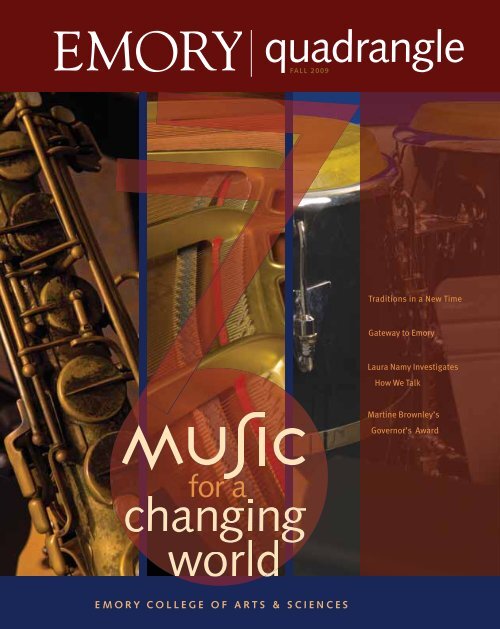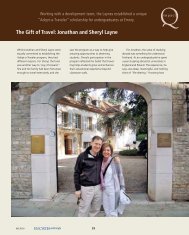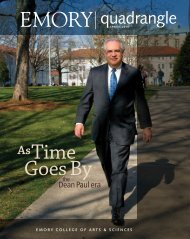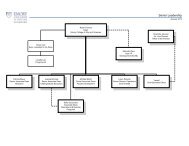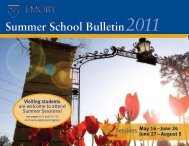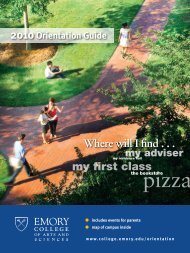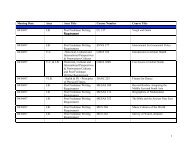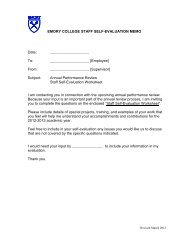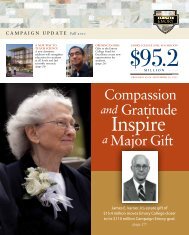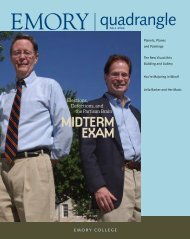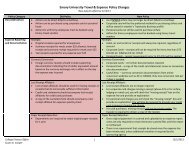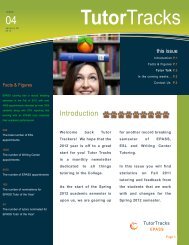quadrangle - Emory College - Emory University
quadrangle - Emory College - Emory University
quadrangle - Emory College - Emory University
- No tags were found...
You also want an ePaper? Increase the reach of your titles
YUMPU automatically turns print PDFs into web optimized ePapers that Google loves.
<strong>quadrangle</strong>FALL 2009Traditions in a New TimeGateway to <strong>Emory</strong>Laura Namy InvestigatesHow We TalkMartine Brownley’sGovernor’s AwardEMORY COLLEGE OF ARTS & SCIENCES
PAGE 10PAGE 14PAGE 6PAGE 8
table of contentsFEATURESTraditional In a New Time 10–13A world, and a web, full of <strong>Emory</strong> storiesMusic for a Changing World 14–17Baroque to tango, the music department has it covered. Gamelan, anyone?DEPARTMENTS2–3 Dean’s LetterPAGE 44–7 ProfilesLaura Namy investigates how we talk—with and without words;Morgan Amanda Fritzlen has two majors, three concentrations,and enough health problems to daunt anyone else.8–9 Q CornersA gateway both old and new.18–19 Eagle Eye20–21 BookmarksClifton Crais and Pamela Scully plumb a fascinating double lifein Sara Baartman and the Hottentot Venus; more faculty books.22–24 KudosMartine Brownley’s Governor’s Award lifts the humanities; otherrecent faculty achievements.25–28 ImpactIt’s Advantage <strong>Emory</strong> for innovative financial aid; share the funof Awards Night and a Campaign kickoff.PAGE 22
Public debate, almost everyonewould agree, is one of the cornerstonesof our system of governance.But it more often seems like arelic, glimpsed in scratchy blackand-whitenewsreels or sentimentalmovies. When debate breaksdown, it breaks into simple binarychunks: dissent or patriotism, hawksor doves, left or right, with us oragainst us. What we’re left with isnot governance, or even thought,really, but mere illogic and screamingpartisanship.Editor: DAVID RANEYArt Director: STANIS KODMANLead Photographer: KAY HINTONProduction Manager: STUART TURNERContributing Writers: HAL JACOBSCAROLE MEYERSContributing Photographer: BRYAN MELTZCorrection:In the spring issue we mistakenly omitteda photo credit for Joe Boris (p. 28).Switch on virtually any public affairs program featuring more than oneviewpoint and you’re greeted with shouting. It isn’t just the volume but thecontent—or lack of it—that’s disturbing. At some point we seem to have agreed,as a nation, to retreat into intellectual armed camps and lob grenades rather thantry to persuade anyone that our position, whatever that might be, is best.Commentators with substantial audiences compare public figures whoseopinions they can’t abide to Hitler and the Nazis. Even in Congress, wheredeliberations ought to be both deeper and more decorous than your averageradio call-in show, the obligatory “My distinguished colleague” is too often followedby strident character assaults and sloganeering.Employed as I am by an institution of higher education, I find this troubling.At the same time my position gives me more reason than most to hope.That’s because colleges and universities are precisely the place where realdebate happens and, more important, where it is taught. <strong>Emory</strong> has a veryfine debate team, winner of more than twenty national team or individualchampionships. But we should look beyond tournaments for a moment.Yes, debate means squads of bright students testing the truth of a provocativestatement. More broadly, though, it means the art of disagreeing productively: ofpublicly, openly working through the complexities of some thorny question. Andthis means accepting that some of the thorns will scratch you. A question thatholds difficulties only for your opponent isn’t worth debating at all.In this larger sense, our faculty and students fill every minute of the schoolyear and every square foot of <strong>Emory</strong> with debate. In classes and conference rooms,offices and labs all over campus, debate is constantly afoot. A good liberal arts collegeis the world’s greatest debate team.In the classroom, faculty go out of their way to present multiple theories andideas. They do the same at conferences, at faculty governance meetings, in articlesand books. Critical thinking requires this and follows from it: proposing, sorting,weighing, considering. The point is to examine all truths, new or received, andreach an informed judgment on their merits.We are all here to think, in other words, not to take sides and defend themat any cost. “Thinking,” as Robert Frost once noted, “is not agreeing or disagreeing.That is voting.”2 fall 2009
A good liberal arts college is the world’s greatest debate team.It might be useful to put a few more words on the witnessstand. “Persuade,” for example, does mean “to winsomeone over,” but the word shares a root with “sweet.” Wepersuade by sweet reason, not verbal barrage, and the peoplewe persuade are not prisoners of war but new allies.Likewise “compromise,” which in current discourse soundsmore like “capitulation.” It’s worth remembering that the firstpart of the word means “together.” Compromise is somethingwe do intentionally, with a common goal; it is not grudginglyceding territory to a hated foe.Finally, “argument.” Epithets are not arguments. The word’sroots include one meaning “to make clear,” and the real articleis on view all over <strong>Emory</strong>: in our State of Race dialogues andMideast debates, for instance, and in a recent Ethics Centerpanel featuring Presidents Wagner, Elizabeth Kiss and RobertFranklin (of Agnes Scott and Morehouse <strong>College</strong>) on “The Roleof the Ethically Engaged <strong>University</strong>.”What substitutes for this meeting of minds elsewhere inthe public realm can sometimes seem like a bad remake ofWho’s Afraid of Virginia Woolf, with all the hurled stemwareand insults but none of the wit.We can do better. And a liberal arts college is one of thebest places to learn.In our fast, fractured media environment, few of us couldmake it through the 1858 Lincoln-Douglas debates, each ofwhich lasted three hours. But <strong>College</strong> faculty still teach, andexemplify, the same rigorous approach to complicated problems.We ought to be reasoning, not bellowing, our way to solutions,which means entertaining more than one idea at a timeand listening to other voices than our own.An uncomfortable corollary of thisis the certainty that we’ll sometimes bewrong. But if we can’t admit this possibility,whether the subject is history, biologyor public policy, then we’re not reallyarguing. We’re just talking, fingers firmlyin ears. And if you’ve ever seen a childdo this, perhaps you’ll agree that at suchtimes we might be called many things,but not (arguably) adults.ROBERT A. PAUL, PhDDean of <strong>Emory</strong> <strong>College</strong>of Arts and Sciencesfall 2009 3
LAURA NAMYGESTURES TOWARD UNDERSTANDINGby David RaneyIf you’ve ever wondered what (orif) your kids are thinking, or beenstruck speechless by the way they latchonto language, you’re guaranteed toget a lot out of an hour in Laura Namy’soffice or classroom.Namy, who joined <strong>Emory</strong>’s psychologydepartment in 1998 and is now anassociate professor, studies early wordlearning and conceptual development.At the Language and Learning Lab justoff campus, Namy and colleagues watch,listen and record children’s responses tolanguage. She’s trying to learn just howhumans do it.How do we, as babies, sort throughthe noisy mysterious stuff that makesmeaning? Think of the swirl of it: soundswe don’t know yet as words, objects theymight (or might not) refer to, facial expressionsand body language that should beambiguous, if not downright unintelligible.Yet we learn to make sense of it all.“It’s fascinating,” says Namy, the editorof Journal of Cognition and Developmentand author of more than twenty articlesin the field. “Humans have evolved withsome general capacities to do things likeremember, pay attention, recognize patterns.One of the things I’m interested inis when these ‘domain-general’ learningmechanisms get tailored to language.”She cautions that however common itmay be to speak of brains as computers, “Itisn’t so much a matter of being ‘wired’ forthis or that specific ability. Pattern recognition,for example, can help you see a tigerin the grass, which would have helped earlyhumans, but that same cognitive capacitycan lend itself to lots of other skills—includingthe trick of discovering how languageworks. I’m interested in the point wherethese targeted cognitive systems adaptfrom more general ones.”Comparison is one tool that infants andtoddlers use to bring order to their world,and Namy uses it to study their progress.“Being able to look at two things, whetherit’s objects, situations, or memories, andidentify what’s common between them,despite many differences—that process ofcomparing and aligning is going to lead togeneralization and insight.“Let’s say you have”—Namy rummagesin a drawer and comes up witha plastic figurine—“an owl. What is the‘owlness’ of this? Size, shape, color? Butif you give children two owls, they’ll spontaneouslytry to figure out what they havein common. They’ll hone in on categoryrelevantproperties: this particular kind ofhead, wing, beak and so on.“One of the neat things about comparisonis you see it at work in infantsrecognizing faces, children recognizingowls, and business students recognizingappropriate negotiating strategies. Thesame mechanism plays out in all thesedifferent scenarios.”As Namy works mainly with kids agedone to four, naturally she’s interested inwhat their parents bring to these learningsituations. That involves watchingand filming them together, and fortunately,she says, “You don’t have to havea camera in the room any more. I havean observation window in my lab in thenew Psychology Building [Quadrangle Fall2007], which keeps the sessions as naturalisticas possible.”One thing she’s found: “Early on,children use gestures spontaneously.They might make one hand motion formore, another for juice, or up. Then asverbal vocabulary develops, the gesturessort of fall by the wayside. While it’s notanything we teach our kids, we wantedto learn what parents do to encouragethis, either with their own gestures or bytheir responses.”Asked whether studying this makesher acutely conscious of gestures outsidethe lab (faculty meetings perhaps?), shelaughs. “It’s funny, there’s a communityof us who study gesture, and almost toa person we tend to be very flamboyantgesturers ourselves. But really everyone isremarkably sensitive to this. If I communicatesomething verbally, adding a gesturethat provides more information, and thenyou’re asked to retell what I said, you’llintegrate that information without evenbeing aware the gesture occurred.”As Namy points out, our sensitivity toprosody (tone of voice) can be remarkable,too. “When we stress words in certainways, for instance by saying eNORmous4 fall 2009
“We’d love to extend that reseach fromobjects to actions to abstract concepts,like joy. How far does it go?”or teeny-weeny, we’re doing with our voicewhat we would call an iconic gesture withour hands. And kids get that. Even withmade-up words, pre-schoolers can reliablyinfer from these cues whether a wordshould mean big or small, hot or cold. Wecan even filter speech so that content isgone and all that’s left is tone of voice.Remember Charlie Brown’s teacher inthose TV specials? It sounds a bit like that.And even then, people can guess. Nowwe’re studying 15-month-olds. It wouldbe really exciting if kids that age were ableto do that.”Another part of the puzzle is soundsymbolism. In English, for example, “slwords often refer to slippery or slimy things,and sn words to nasal things” (think sniffleand snort). “And while that’s not true forall words in every language, there is somethingabout certain sound clusters thatmakes them common carriers of meaningacross languages. If you play an Urdu wordto native English speakers who’ve neverheard Urdu and ask them to say if it meanstall or short, they guess right more oftenthan chance would allow.“We’d love to extend that research,from objects to actions to abstract concepts,like joy. How far does it go?”As you might expect after that hourin her office, Namy also loves to teach.She recently coauthored an introductorytextbook and developed a course aroundit this year. “I’m excited about that. I alsoteach a 300-level cognitive developmentcourse and a small writing-intensiveseminar on language acquisition. In allof them I want to help students reasonabout evidence. I think the best thing wecan do in our classrooms is give peoplethose tools.“That’s the thing I love most aboutteaching undergraduates. I’ll say here’sthe question, here’s how they administeredthe study—what’s the logic? Andsometimes they’ll discover: Wait a minute,that doesn’t make sense. I love when thathappens. I just think that’s so valuable.”For more information about the ChildStudy Center, or to find out how to participatein child development studies at<strong>Emory</strong>, go to http://www.psychology.emory.edu/childstudycenter.fall 2009 5
MORGAN AMANDA FRITZLEN LIFE AT THE INTERSECTIONby David RaneyShe crosses Asbury Circle from hospital to campus, looking bothways—a traffic accident is all she needs—and settles on a benchnear Candler Library. In pink paisley pajamas, cardigan and crocs,sipping a quadruple-shot café Americano, she’s indistinguishablefrom other undergraduates lounging and walking nearby, discussingthis week’s readings or last night’s social highlights. Butthe short walk covers more distance for Morgan Amanda Fritzlenthan for most.When she started at the <strong>College</strong>, Morgan Amanda knew sheeventually wanted to study adolescent medicine; she just didn’trealize which side she’d be studying it from. In her 2003 <strong>Emory</strong>application she hopes for “an outstanding pre-medical education,”possibly with “the opportunity to participate in researchat one of the university’s facilities such as the Winship CancerInstitute . . . gaining more experience for my future profession.”She has certainly become a student of medical issues, but theexperience has come largely as a patient. A cascading series ofhealth problems, including genetic and acquired joint, vascularand connective-tissue disorders, has kept Morgan Amanda onmore intimate terms than she ever would have guessed with physicians,nurses, interns and aides. To manage some twenty overlappingconditions, in addition to dozens of allergies, she takes abewildering variety of medications and has undergone twenty-twosurgeries—twelve just since writing that application essay.And she has kept writing.Derailed from a pre-med track after missing five weeks as asophomore due to illness, Morgan Amanda has since fashioned adouble major in linguistics and interdisciplinary studies with a tripleconcentration: linguistics, literature and medicine. Her seniorhonors thesis began as a semester-long assignment in a coursecalled “Creative Writing and the Health Sciences” describing hermedical and academic life. Now weighing in at over 230 pages,it has evolved into quite a different animal but retains some ofits original point and purpose. This kind of shape-shifting hasbecome something of a theme in Morgan Amanda’s life.She is eloquent on the effects of being both student andpatient, as well as on the ways that people (herself included)perceive illness. “It constantly changes,” she says. “Illness is anoutside-inside experience,” one that challenges the borders thatwe rely upon between ourselves and the external world, andbetween bodies—as in the case of transfusions and transplants,both of which Morgan Amanda has experience with.6 fall 2009
Her thesis explores all this and more, narrating with humorand absolutely no sentiment the disorienting doubleness of beingenmeshed in both chronic illness and an academic career; of spendingtime on oncology wards although she doesn’t have cancer; ofreceiving treatment for some conditions as a pediatric patient, othersas an adult. There’s a reason the working title is Sphinx.“I often feel more a part of <strong>Emory</strong> Healthcare than <strong>Emory</strong><strong>College</strong>,” Morgan Amanda says recently over a cup of coffee.describes her as “amazing”—a word that recurs frequently—aswell as “tough, bright, gentle and caring.” Her writing, Newbythinks, could mark a real step forward in helping physiciansunderstand treatment from a patient’s perspective. “I can’timagine anyone with a better understanding of the interactionbetween the science and art of healing.”Similar accolades flow from her professors. Morgan Amanda“has surprised me with her innovative approach to language,”according to Benjamin Hary, associate professor oflinguistics. But he adds that “this alone would notmake her unique. I have always been amazed ather resilience, her caring toward her peers, and herdeep friendships.”Richard Levinson, Candler Professor in theRollins School of Public Health, teaches a courseon the sociology of health and illness in which,again, Morgan Amanda stood out: “She’s verybright, mature beyond her years, serious and independent.Morgan Amanda was unlike her peers.”“Her work is amazing,” says Angelika Bammer,associate professor in the Institute of Liberal Artsand Morgan Amanda’s advisor in InterdisciplinaryStudies. “Being around her is always bracing—the effect for me is that I see the world somewhatdifferently, as if a gauze had been strippedaway. That is how she writes, as well: clearly,sharply, honestly. She makes me want to be thebest teacher I can possibly be.”“I can’t imagine anyone with a better understandingof the interaction between the science and art of healing.”“I probably have more friends among med students and healthproviders than undergraduates, simply because I’ve spent moretime on that side of the street.” Her parents (“I literally owe themmy life”) moved or commuted from Chicago to Atlanta to helpwith her care, in the process providing, as she notes, yet anotherirony: “I’ve virtually gone to school with my parents; most peoplego to school to get away from them.“I’ve never really been a normal student,” Morgan Amandaadmits. In her second semester she took midterms in her dormroom, proctored by her resident advisor, after contracting viralmeningitis. A comparative literature instructor once droppedoff a draft of a paper when she became too sick to leave herroom. “<strong>Emory</strong> has been exceptionally supportive of my nontraditionalacademic experience,” she says. “I’m very gratefulfor that.”The feeling appears to be mutual. Now a Phi Beta Kappa senior,Morgan Amanda is finishing her degree one course at a time, andthe people she’s touched at <strong>Emory</strong> can’t say enough about her.Wendy Newby, associate dean in the Office for UndergraduateEducation, has known Morgan Amanda since freshman year andJim Grimsley, senior resident fellow in creative writing, agrees.“Writing is not her central interest,” he notes, “but it certainly couldbe, with talent like hers. The notion of youth hardly applies to her;she writes as if she’s already lived for centuries. Morgan Amanda isone of those students who make a professor feel humble and honoredto teach.”Cathy Caruth, Winship Distinguished Research Professor ofComparative Literature, came to the same conclusion two yearsago after Morgan Amanda proved herself “one of the top studentsin a brilliant class. She is inspired.” Morgan Amanda, Caruthsays simply, “can do anything she wants.”She’d still like to go to medical school, Morgan Amanda says,“If I’m healthy enough. If not, I’ll go into health care administrationor patient advocacy. But I want to do something meaningfulwith my life, and I plan to use my experience. I’d like to giverather than take all the time.“I used to stress about the future,” she says after a pause.“About medical school and so on. But now I feel calmer. GuessI’ll cross that one when I come to it.”fall 2009 7
In thinking over what I could do to honor these two great and good men, Haygood and Hopkins, and keep their names before the youth ofthe land, it occurred to me that a gateway at the entrance to the campus of <strong>Emory</strong> <strong>University</strong> would be the best thing. (Linton B. Robeson,Class of 1886, at the 1937 dedication of the gateway)GATEWAY CONNECTS EMORY GENERATIONS by Hal JacobsIt’s no surprise that the restored Haygood-Hopkins gatewayat the front entrance to campus invokes strong feelingsamong people who care deeply about <strong>Emory</strong>’s historyand traditions. After all, the restoration of the gateway, oneof the <strong>University</strong>’s traditional icons, to its rightful place onDowman Drive addresses a wrong—actually a wrong turn—that had plagued the wrought iron arch over the years as largetrucks repeatedly smashed into it.A few years ago, Marshall Duke, Candler Professor ofPsychology, devoted part of his commencement speech to theOxford <strong>College</strong> class of 2006 to describing the cultural significanceof the gateway. A gift from Linton B. Robeson 1886C,the monument was intended to deepen the connectionbetween “Old <strong>Emory</strong>,” the original campus at Oxford, and thenew Druid Hills campus by honoring the two <strong>College</strong> presidentsduring Robeson’s undergraduate years: Atticus GreeneHaygood (1875–1884) and Isaac Stiles Hopkins (1884–1888).Duke enjoined the Oxford graduates to honor this connectionby entering the <strong>Emory</strong> campus for the first time by walkingthrough the Haygood-Hopkins gates. While doing so, he askedthem to pause and read aloud the words on the left pillar honoringHaygood: “Let us stand by what is good and try to makeit better.”You might say the inscription fits the restoration project itself.The work began as a result of a proposal to build a traffic roundaboutfor <strong>Emory</strong> Village that first gained momentum in 1999.According to <strong>University</strong> architect Jen Fabrick, <strong>Emory</strong> then negotiatedwith DeKalb County and the Alliance to Improve <strong>Emory</strong> Villageto redesign the intersections of Oxford Road and Dowman Drivewith North Decatur Road, creating a one-way entrance into <strong>Emory</strong>8 fall 2009
“LET US STAND BY WHAT IS GOOD AND TRY TO MAKE IT BETTER.”through the historic gateway. (<strong>Emory</strong>’s Board of Trustees approvedconstruction in 2006; work began in 2008 when the roundaboutproject began moving forward.)This time around, to make it possible for fire trucks and schoolbuses to pass safely under the iron work and lantern, the gatewayitself was raised slightly and the newly bricked roadway surface waslowered. Also, in a nod to the original entrance, the road curvesto the right after the gates so that a visitor first looks into BakerWoodlands [Quadrangle Spring 2006] before passing FishburneDrive and heading through a canopy of trees (the hardwoods areyoung now, but just wait 20 years) over the Woodland ravinetoward the Administration building.The additional marble columns on either side and the granitewalls (including one faced with marble and inscribed with the<strong>Emory</strong> name and insignia) were designed to enhance the grandeurof the entrance. “The community has told us it’s the best thingwe’ve done,” Fabrick says. “They love that it adds to the prestigeand the whole environment here.”Gary Hauk, vice president and deputy to the president, saysthat one of the attractive things about the gateway in its currentincarnation is that it lends itself to certain kinds of traditions orlegacies. “We are still considering ways to use it as a rite of passagefor students coming into <strong>Emory</strong>,” he says.On a summer afternoon, visitors can already be seen stoppingin front of the gates to take photos of a friend or familymember. And for people heading back and forth to theVillage, it’s become a nice spot to pause a few minutes and talk.Duke believes the restored gateway ranks right up with therenovation of the Matheson Reading Room in Candler Library.“There’s an invisible force at <strong>Emory</strong> that seems to drive us tocorrect those things that violate in some way the essence of thisplace—its history and traditions,” he says.For a YouTube video about the Haygood-Hopkins gate, seehttp://www.youtube.com/watch?v=6lm9qk8rlf8. Do you knowthe soldier in the opposite photograph? If so, write us atdraney@emory.edu.Top right: Architect Jen Fabrick (left) with <strong>Emory</strong> vice president Rosemary MageeBottom right: Preliminary drawing for entrance roundaboutfall 2009 9
10 fall 2009
y Carole Meyersillustration by Christiane BeauregardIt hardly seems possible that we started surfing the World Wide Web in 1992. Or that ten short years ago, wireless networks started showing upin our homes and universities. Indeed, the degree of transformation wrought by the “networked revolution” has been so quick and so completeas to render the idea of an unconnected student almost unimaginable.It is against this rush of technological change that <strong>Emory</strong> <strong>College</strong> has had to develop its online philosophy, which could be briefly stated as:Technology exists to enhance the in-class, residential experience at <strong>Emory</strong> <strong>College</strong>, not to replace it.The resulting projects span <strong>College</strong> disciplines and activities, and they provide a glimpse at how comprehensively the <strong>College</strong> has goneonline. Here are just a few examples.SOUTHERN SPACES<strong>Emory</strong> is home to one of the first peer-reviewed online journalsin the nation, Southern Spaces. Focusing on “real and imaginedspaces and places of the U.S. South,” Southern Spaces takesadvantage of the web’s capability to deliver audio, video andinteractive imagery, in addition to text, and explores new ways oforganizing and updating research using these multiple media.Southern Spaces launched in February 2004, a partnershipbetween a loose group of faculty, graduate students, and stafffrom Robert W. Woodruff Library and Academic TechnologyServices who had an interest in exploring the new scholarly possibilitiesof the web. “I think what we recognized was the realpotential to combine these media elements into one new format,”says Allen Tullos, professor of American studies. “It justseemed like an exciting new way to present things that youcouldn’t do any other way.”In the early days, the group frequently had to work withexisting pieces, largely text, and would have to collaborate withcontributors to find materials to accompany it. Five years later,Southern Spaces routinely receives submissions with accompanyingmultimedia files, often with permissions for use alreadyobtained. “We’re really getting a whole new group of scholarswho compose pieces in multimedia formats,” says Tullos.A piece like Scott Matthews’ essay on musicologist JohnCohen’s documentation of Appalachian musician RoscoeHalcomb embodies the possibilities of the new genre. Matthewscombines his own textual analysis of Cohen’s journey into easternKentucky in the late 1950s and early 1960s with periodmaps, audio music clips, and both still and moving images ofHalcomb and the musicians he influenced. The result is a rich“reading” experience that leaves you with a deep, broad understandingof the topic.Multimedia pieces like Matthews’ require an array ofresources to produce. The journal relies on a cadre of graduatestudents who have learned to create web pages, to formatimages correctly, and to digitize and store audio and videofiles in multiple formats. <strong>Emory</strong>’s Woodruff Library also playedan instrumental role, hiring technical staff and developing thenecessary server infrastructure, supported by a grant from theAndrew Mellon Foundation.ITUNES U<strong>Emory</strong> is showing up online in other arenas as well, most notablyvia participation in Apple’s iTunes <strong>University</strong>. <strong>Emory</strong>’s iTunes U sitewent live in October 2008 with both a public site and an internal,<strong>Emory</strong>-only site for distributing lectures and teaching materialsto registered members of a class. The public site featuresfall 2009 11
<strong>College</strong> faculty have created short videosranging from Carol Herron on why studentsshould study French at <strong>Emory</strong> to DeborahLipstadt on Holocaust denial to Salman Rushdieon creativity.compelling means of instruction in languages thatare less commonly taught, like Cherokee, Kannada,Armenian and Twi. These language collections havebeen consistently featured by Apple on their iTunesU homepage. Other Apple features from <strong>Emory</strong>have included the Life of the Mind series, the KingTutankhamen exhibit, Cartooning for Peace, andlast fall’s Evolution Revolution conference withE.O. Wilson.content from campus visits by His Holiness the Dalai Lama, AliceWalker, Edward Albee, and Umberto Eco. In addition, <strong>College</strong>faculty have created short videos ranging from Carol Herronon why students should study French at <strong>Emory</strong> to DeborahLipstadt on Holocaust denial to Salman Rushdie on creativity.iTunes U serves up podcasts or “vodcasts” (video podcasts)via the Apple iTunes store, which allows anyone with the iTunessoftware—freely available for Macs and PCs—to downloadstracks of interest for playback at their convenience. <strong>Emory</strong> oniTunes U averages 30,000 downloads a week, and at this printinghas reached more than one million total downloads. Audio andvideo from <strong>Emory</strong> <strong>College</strong> have been featured on Apple’s iTunes Uhomepage, with Chemistry Professor David Lynn’s lecture on “TheOrigins of Evolution” ranked as high as #20 for all of iTunes U.Podcasts from <strong>College</strong> language departments have beenamong the most downloaded, in particular short tracks demonstratinghow to form letters in non-Western languages likeMandarin, Kanji, and Armenian. iTunes U provides a particularlyECIT & DIGITAL STORYTELLINGAs anyone who has worked with a computer knows,there always comes that critical time when you needtechnical support: someone to fix, advise, orient, andexplain the mysteries and possibilities of the digitalworld. For help with things like making podcasts foriTunes U, the place <strong>College</strong> faculty go is <strong>Emory</strong>’s Centerfor Interactive Teaching (ECIT), a part of <strong>University</strong>Technology Services.At ECIT, faculty, staff, and students can access specializedhardware and software and get help fromtrained instructional technologists on everythingfrom putting classes into <strong>Emory</strong>’s course managementsystem, Blackboard, to preserving lectures withCamtasia screen-capture software. Workshops areheld throughout the year, and each summer ECIT hosts “<strong>Emory</strong><strong>College</strong> Online,” featuring week-long teaching sessions on particulartopics—using blogs, creating and editing audio files, orparticipating in <strong>Emory</strong>’s online community, LearnLink [QuadrangleSpring 2008].This past summer ECIT branched out with a new additionto <strong>Emory</strong> <strong>College</strong> Online, a workshop on “Digital Storytelling.”Six faculty participated from departments across the <strong>College</strong>,including environmental studies, music and English, plus theInstitute of Liberal Arts and the Office for UndergraduateEducation. The workshop was conducted by ECIT directorWayne Morse and coordinator Chris Fearrington.So what makes digital stories different? Typically, a digitalstory—a three-to-five-minute movie using images, voice andmusic to deliver a narrative—distinguishes itself from otherpod- or vodcasts by its personal nature. “The session on digitalstorytelling provided faculty a new way to engage their students,”explains Morse. “The goal was to use the sharing of the12 fall 2009
faculty’s feelings towards their own subjects to better provideinsight into the course and its content.”As a composer and faculty member in music, Gary Motleycame to digital storytelling with experience in translating an idea oremotion into a different form. For Motley, the workshop was lessabout learning new software, as he was familiar with most of thetools used, than about exploring new possibilities for composition.“The session on digital storytelling providedfaculty a new way to engage their students,”explains Wayne Morse.“I wanted to find out more about the whole concept,” he says.“How to put these things together—audio, video, music—intoan effective story.”Motley had planned to create a piece to encourage interestin his jazz improvisation class, but as he learned more aboutthe personal nature of digital stories, he took another direction.“As I got into the digital storytelling thing,” he says, the ECITstaff “talked about making something personal, as it was reallyyour story that you’re trying to tell. And I thought, Maybe I canmotivate students by showing them what motivated me to wantto play this music.”Motley saw a new opportunity in working with visual images.He originally thought to accompany his voiceover with photographsof famous jazz artists: Miles Davis, John Coltrane, Ella Fitzgerald.As he explored his own feelings about jazz, though, he realizedthat artwork could get to the essence of jazz in ways that eludedwords and that photographs did not capture. “There’s a certainpart of jazz that is based around improvisation, and a lot of theartwork that I chose was very impressionistic, more suggestivethan anything,” he says. “There were a couple things in therethat were really abstract, and if you looked at them I think theysaid more than I could put into words. And that was the biggestthing that I was looking for.”Motley plans to tell more digital stories: about music departmentcourses, about his new jazz studio, about the jazz programitself. He sees creative possibilities in the merging of technologywith what is typically a conservative musical genre. “Now I say thatjazz is the thing I love to do, but I’m going to show you a differentway to deal with jazz,” he says. “Still traditional, but traditional ina new time. You can push the envelope here without abandoningthe values. If we can keep the values, we’ve got it.”This could be the story of <strong>Emory</strong> <strong>College</strong>, too, as it developsa technological approach that is “traditional in a new time.” It’s alesson worth recalling during our generation’s race with change. Byfocusing on enhancing the in-class experience with online content,the <strong>College</strong> is expanding its reach while remembering its roots.The different technological options available today are as diverseas the spectrum of study at <strong>Emory</strong> <strong>College</strong> and limited only byindividual imagination. To see some online stories in action, checkout the following URLs:http://www.southernspaces.org/http://cet.emory.edu/ecit/http://itunes.emory.edu/fall 2009 13
As <strong>Emory</strong> welcomes one of itsmost diverse freshmen classesever to campus this fall, studentswill find a music department thatreflects many of their own richcultures and new approaches tomaking music.In addition to continuing a strong focus on European classical music, the department offersan eclectic mix of jazz, Korean drumming, the music of India (South and North), Javanesegamelan (Western and Central), tango, electronic synthesizers and cutting-edge music compositionsoftware, and more. Over the last decade, the department has transformed itself intoa place where the study and performance of music across cultures shares equal billing withthe masters of European classicism.By all accounts, one of the main reasons behind thistransformation was the 2003 opening of the Donna andMarvin Schwartz Center for Performing Arts, which has“upped the department’s profile considerably,” accordingto Steven Crist, chair of the music department and associateprofessor of music history.While the facility has delivered world-class acoustics andconcert space, it has also elevated the visibility of all types ofmusic at <strong>Emory</strong>, says Rosemary Magee, vice president and secretaryof the university. She points to performances that rangefrom classical composer Osvaldo Golijov to French composerOlivier Messiaen, ensembles ranging from Bang on a Can tothe New York Philharmonic, performers from classical violinistJoshua Bell to jazz pianist Gary Motley, and “the pleasures ofhearing the gamelan for the first time in the concert hall.”Students have responded enthusiastically to the newcultural vibe. Since the Schwartz Center arrived on the scene,the number of music majors (most of them co-majoring inanother area) has nearly doubled from about 80 to 140.Along with the influx of new students has come a new attitudeabout engaging music—an openness to other culturesand an eagerness to make music of their own. This generationof students who grew up with Guitar Hero on their Xbox cannow find music classes where they can begin playing togetherand writing music after a few weeks, not the long years of rigoroustraining required to play classical music.14 fall 2009
y Hal JacobsSteve Everett, professor of composition, electronic and computermusic, embraces the change. “We’re going back to a folkculture where everyone has tools and can participate,” he says.Everett speaks from personal experience. As a collegestudent, he never strayed far from the chords and harmoniesof classical music on his way to becoming a trumpet player inthe Atlanta Symphony. By chance, he attended a music workshopled by composer and conductor Peter Maxwell Daviesat Dartington Hall in Devon, England. There he was exposedfor the first time to the gamelan, an intricate set of percussioninstruments from Indonesia. “The class opened my eyes tothe idea of creating music and seeing music from all over theworld equally,” he says. “Suddenly music had more meaning,more power, than I’d ever been taught.”Over the next several years, Everett began to study ethnomusicologyand traveled to India, Indonesia, Singapore, HongKong and other places, trying to understand music from othercultures. In 1991 he joined the <strong>Emory</strong> faculty and introducedcourses in ethnomusicology; five years later he started agamelan ensemble at <strong>Emory</strong> that continues now under ethnomusicologistTong Soon Lee.drums and gongsA big turning point for the study and performance of worldmusic at <strong>Emory</strong> came in fall 2001 with the arrival of Lee, associateprofessor of ethnomusicology. Like Everett, Lee had his ownroad to Damascus moment involving classical and non-Westernmusic. Trained in classical music throughout his childhood yearsin Singapore, Lee was attending college in England when—hestill remembers the day—his teacher brought a Korean druminto class and started drumming and dancing.“I never knew that there was this whole other worldof music that was so exciting,” he says, adding that he feltashamed that he was at a university studying music andknew nothing about Korean percussion. The experiencespurred him to study ethnomusicology in graduate school atthe <strong>University</strong> of Pittsburgh, where he wrote a master’s thesison the Islamic call for prayer. For his doctoral studies hefocused on Chinese street opera in Singapore; his book onthe subject was published by the <strong>University</strong> of Illinois Pressearlier this year.At <strong>Emory</strong> he’s now responsible for a world music programthat is still in growth mode. In 2006, <strong>Emory</strong> was oneof five universities in the U.S. that received a set of WestJavanese gamelan from a donor interested in spreading theTop Center L–R: Yayoi Uno Everett, Steve Everett, Kristin Wendland, Gary Motleyfall 2009 15
“There’s a Beethoven symphony next to a tango next to a jazz tune. It all gets mixed uptogether in a student’s mind about their interest in music.“use of the instruments in college classrooms. Currently, fiveensembles (with about 30 students in all) play music from Korea,China, India and Indonesia. Lee has tapped into Atlanta’s hugeimmigrant community to bring in guest artists, as well as standing-room-onlyaudiences to concerts. (To see students performingthe <strong>Emory</strong> gamelan at a March 2009 concert, go to YouTubeand enter the search phrase “<strong>Emory</strong> Sekar manis.”)Lee is aware that the gamelan and Korean drums can beenticing to students because of their exotic nature. “Some studentsthink, ‘Wow, this is cool,’ so they want to learn more,” hesays. “The excitement of teaching ethnomusicology is takingthat moment of unfamiliarity and seeing what I can do with it.”Yayoi Uno Everett, associate professor of music theory, isalso involved in teaching and researching music through amulticultural lens. Originally from Yokohama, Japan (she haslived in the U.S. for more than 30 years and arrived at <strong>Emory</strong> in2000), she is currently teaching an upper-division seminar titledBeyond Orientalism that examines musical identity and culturalrepresentation in art forms ranging from nineteenth-centuryWestern opera to Noh drama, Balinese kecak (monkey chant)and global hip hop.from jazz to tangoIn October 2007, when His Holiness the Dalai Lama gave a publictalk on educating the heart and mind in Atlanta’s CentennialOlympic Park, it seemed perfectly fitting that Gary Motley, lecturerand director of jazz studies, and his trio would play in frontof the large gathering. “Jazz is about the human experience, soit was appropriate that we were a part of that,” says Motley.The visibility of the jazz program has been steadily risingsince Motley first arrived in 1996 to teach an improvisationclass. Prior to that he was playing on the road as a jazz pianistand making connections with leading musicians, whichhas led, over the last decade, to national recognition andeven a feature appearance on Piano Jazz with NPR’s MarianMcPartland. Over the same period, his one <strong>Emory</strong> classturned into two, one ensemble became two, then the big bandfell under his purview, then the entire jazz program. The numberof students in the program and the quality of music haveincreased exponentially, says department chair Steven Crist.Motley now has a dedicated space for jazz in theBurlington Road Building featuring an interactive whiteboard that allows him to stand in front of the class, toucha single note on the charts with his finger, move it up or down,then play back the music so everyone can hear the changes(see the YouTube video at http://www.youtube.com/emoryuniversity#p/u/6/RSEVkUCOJql.).“The technology is exciting,” says Motley, “but whatI’m really excited about is promoting jazz as an art form andthe involvement of <strong>Emory</strong> students in learning about jazzand performing jazz.”To keep jazz on the front burner, Motley is bringing inguest artists—this fall, 23-year-old bass sensation EsperanzaSpalding will perform and teach a master class, as will “elderstatesman of the bass” John Clayton—and in February he’llpresent a new lineup for the annual jazz festival at <strong>Emory</strong>.He credits the faculty in the music department for creatingan environment that allows music across cultures to flourish.“There’s a very healthy respect in this faculty for each otherand what we bring to the table,” he says. The respect allowsfor some exciting collaborations: in the last couple of yearsalone, he’s collaborated with the Vega String Quartet and the<strong>Emory</strong> Tango Ensemble.Kristin Wendland, senior lecturer and director of the TangoEnsemble, credits the music department faculty for placingpopular music and world music on an equal footing with thestandard European canon. As the only faculty member in thedepartment who teaches Latin American music, her classes andensembles reach out to a growing number of Latina and Latinostudents. (She is also quick to point out that tango, like jazz, istruly international.)Since she began organizing tango events at <strong>Emory</strong> in 2001,she has seen an explosion of interest beyond classical music.She believes that today’s students are more comfortable withchoosing music from a range of cultures and genres. In fact,she’s joined a team of authors developing a new online musicappreciation project for just this generation (“Music iAppreciation,”due out in 2010 by Pearson Prentice Hall) that will givestudents the tools to analyze and enjoy classical, world music,jazz and popular music.“Students mix everything together,” she says. “I like touse the metaphor of what’s on a student’s iPod. There’s aBeethoven symphony next to a tango next to a jazz tune. It allgets mixed up together in a student’s mind about their interestin music. I think that’s what we’re doing in our department.We still keep channels clear historically, but we’ve also becomebroader to reach this generation of students.”Perhaps no musical entity at <strong>Emory</strong> embodies the iPodmetaphor better than the Vega String Quartet, which hasdazzled audiences with both classical and boundary-bendingperformances. William Ransom, Mary Emerson Professor ofPiano, developed the residency as artistic director of the <strong>Emory</strong>Chamber Music Society. “In addition to performing Mozartand Beethoven,” Ransom says, “Vega has played traditionalChinese music, tango with Kristen Wendland’s group, and anew opera by Steve Everett. For the Vega, there is no divisionbetween classical, world, popular, folk, and traditional—thereis only good or bad music.”16 fall 2009
In addition to jazz and world music, the musicdepartment offers a full range of classical musicprogramming for <strong>Emory</strong> students.university chorus. Large mixed choir of 150singers that welcomes students, faculty andstaff. (Eric Nelson, Director)symphony orchestra. 100-member orchestradraws its membership not only from theDepartment of Music but from all disciplinesacross the campus. (Richard Prior, Conductor)wind ensemble. Performs four concerts eachyear on the <strong>Emory</strong> campus. (Scott Stewart,Conductor)concert choir. Considered one of the finestcollegiate choirs in the country. (EricNelson, Director)chamber ensemble. May include BrassEnsemble, Jazz Combos, Tango Ensemble,Guitar Ensemble, Percussion Ensemble,Piano Duo/Trio, Saxophone Quintet, StringQuartet, and Woodwind Quintet. (RichardPrior, Director)collaborative piano. For pianists interestedin performing chamber music literature withanother instrument. (Deborah Thoreson,Director)guitar ensemble. Classical guitar ensemblethat studies and performs music for guitarduos, trios and quartets. (Brian Luckett,Director)big band and jazz combo. Four jazz chambergroups and an eighteen-piece big band.(Gary Motley, Director)world music ensemble. Ensembles includeSouth Indian classical music, North Indianclassical music, Central Javanese gamelan,West Javanese gamelan, Chinese classicalmusic, and Korean percussion.(Tong Soon Lee, Director)
18 fall 2009
Astudent finds a quiet—but colorful—spotin the new Psychology and InterdisciplinarySciences Building.fall 2009 19
Featured TitleSara Baartman and the Hottentot Venusby Clifton Crais and Pamela ScullyPrinceton <strong>University</strong> Press, 2009Clifton Crais is professor of history with a specialty inAfrican history. Pamela Scully is professor of women’sstudies, focusing on comparative and women’s genderhistory. Both joined the <strong>Emory</strong> faculty in 2004.Excerpt:Sara Baartman and the Hottentot Venus have had mysteriouscareers. Sara Baartman was born on the South African frontierin the 1770s. She lived nearly three decades in South Africa. Shethen spent some five years in Europe before dying in Paris at theend of 1815. Sara Baartman loved, and was loved, and for manyyears before she went to Europe she was a mother and a workingwoman in the Cape. Yet she has come down to us in history capturedby the icon of the Hottentot Venus, a supposedly paradoxicalfreak of race and sexuality, both alluring and primitive, thevery embodiment of desire and the importance of conqueringthe instincts. Writings on Sara Baartman have subsumed the lifeof this beautiful woman almost totally in those brief, if momen-Recent <strong>Emory</strong> <strong>College</strong> Faculty BooksDelores Aldridge. Imagine a World: Pioneering BlackWomen Sociologists.Patrick Allitt. The Conservatives: Ideas and PersonalitiesThroughout American History.Tonio Andrade. How Taiwan Became Chinese.Peter Bing. The Marble and the Scroll.Phillippe Bonnefis. Sur quelques proprieties des trianglesrectangles.Kristen Buras. Rightist Multiculturalism: Core Lessons onNeoconservative School Reform.Patricia Cahill. Unto the Breach: Martial Formations,Historical Trauma, and the Early Modern Stage.C. Jean Campbell. The Commonwealth of Nature.Frans De Waal. The Age of Empathy.Richard Doner. The Politics of Uneven Development.Marshall Duke, Stephen Nowicki and Amy VanBuren. Guiding Relationships in Children.Jennifer Gandhi. Political Institutions Under Dictatorship.Rosemarie Garland-Thomson. Staring: How We Look.Jim Grimsley. Jesus Is Sending You This Message.20 fall 2009
tous, years she spent in Europe displayed as the Hottentot Venus.A short period at the end of her life has come to stand for all thatpassed before.In Cape Town, and then in England and in Paris, SaraBaartman as the Hottentot Venus fancied and troubled theminds of people who, in their often quotidian ways, helped fashionthe modern world. It was, by all accounts, an extraordinaryepoch. During her lifetime American colonists declared theirindependence and quashed Native American cultures. In SaintDomingue, slaves revolted and created Haiti, a new society freeof the plantation master but still full of sorrow. Across Europerevolutions came and went, in France by the stamp of feet andthe guillotine’s percussive thump. Napoleon’s armies marchedand perished. The masses moved in and out of the factories ofManchester, Liverpool, Birmingham, or worked on the docks ofthe great city of London. The Luddites rioted against the factorysystem. Gas lighting came to Soho. King George III went insane.The Romantics imagined the beauties of nature, the emotionsand the transcendental, the monstrous and the exotic. Scientistsmeasured and classified the world.Where, Europeans wondered, did the Hottentot Venus fitin the order of things? What makes us human? What is intellect,feeling, love? Many believed the Hottentot Venus … was a Homosapiens monstrous, a kind of Frankenstein’s monster scarcelycapable of emotion and intelligence yet also a reminder of theprimitive living deep within the self.. . . On Baartman’s death in December 1815, GeorgesCuvier, then Europe’s most revered scientist and the father ofcomparative anatomy, eagerly dissected her body for his investigationsand remade her in a plaster cast as the Hottentot Venus.Sara Baartman disappeared from history as the identity she hadperformed on-stage and in Europe’s halls was entombed in scienceand figured ever more prominently in the Western imaginingof women, race, and sexuality…. A huge illustration of theHottentot Venus greeted the tens of thousands of visitors whocrowded into the Universal Exhibition in Paris in 1889, and herplaster cast was made available to the more than thirty-one millionpeople attending the International Exhibition of 1937, justbefore the outbreak of the Second World War when ideas aboutthe supposed inferiority of the races nearly destroyed Europe.. . . In 1994, apartheid ended. South Africans begandemanding the return of Baartman’s remains for proper burialin the place of her birth…. Sara Baartman thus began appearingfrom history’s shadows. But who was this person who becamethe Hottentot Venus?[We] wondered if a different approach to Sara Baartman’slife might be possible. What if we looked at the totality of her lifeand resisted the temptation of reading her history backward as astory of inevitable victimization? How might the past look then?. . . Sara Baartman’s life confounds conventional narrativebiography. . . . She was in many senses one of the “defeated andthe lost” whose history, as one philosopher put it, “cries out forvengeance and calls for narrative.” Yet the closer we get to thedefeated and the lost, the more fragmentary the evidentiaryrecord becomes. This is the case not simply with Sara Baartmanbut with the great swath of humanity, the billions of people whobequeath posterity the simple lineaments of their lives. . . .And live she did. We are drawn to Sara Baartman’s life andto the strange legacies of the Hottentot Venus. Therein one canfind many fascinating, if disturbing, stories. But her story—orperhaps their stories—also is a cautionary tale about silence andthe limits of history, and about what happens when someone, orsomething, comes to stand for too much, when the past can bearno more.Benjamin Hary. Translating Religion.Harvey Klehr, John Earl Haynes and Alexander Vassiliev.Spies:The Rise and Fall of the KGB in America.Melvin Konner. The Jewish Body.Gary Laderman. Sacred Matters.Frank Lechner. Globalization: The Making of World Society.Scott Lilienfeld, coed. Navigating the Mindfield.----, coed. Psychological Science in the Courtroom.----, Steven Jay Lynn, Laura Namy and Nancy J. Wolff.Psychology: A Framework for Everyday Thinking.Michael Peletz. Gender Pluralism: Southeast Asia Since EarlyModern Times.Philippe Rochat. Others In Mind: Social Origins of Self-Consciousness.Don Seeman. One People, One Blood: Ethiopian-Israelis andthe Return to Judaism.Thomas Walker. Eligible for Execution.Craig Womack. Art as Performance, Story as Criticism.Kevin Young. Dear Darkness.fall 2009 21
kudosMartine Watson BrownleyMartine Watson Brownley, Goodrich C. WhiteProfessor of English, took the stage at theOld Georgia Railroad Freight Depot in downtownAtlanta on May 7 th to receive the 2009Governor’s Award in the Humanities.“Today, when our society tends to focus on the new, the pragmatic, the technological and themarketable, upholding the value of learning for its own sake, as the humanities do, is crucial.”“Dr. Brownley has made an important contribution toGeorgia through sharing the importance of our storiesand traditions,” said Governor Sonny Perdue in selectingBrownley for the award.The Governor’s Awards were inaugurated in 1986 to recognizethose people and organizations “working to increasethe understanding and appreciation of the humanities” in thestate. Brownley has certainly been doing that. The GeorgiaHumanities Council, which solicits public nominations for theaward, chose Brownley among other “humanities heroes” forher championing of the liberal arts both as a scholar and asdirector of <strong>Emory</strong>’s Bill and Carol Fox Center for HumanisticInquiry (FCHI).A specialist in 18 th -century literature, Brownley has beendirector of the FCHI since it opened in 2002. The Fox Centeris a residential research center for humanities scholarship andinterdisciplinary programming [Quadrangle Spring 2006] thatmade headlines in 2005 when it became the only humanitiescenter in the nation funded by the National Endowment forthe Humanities with a $500,000 challenge grant. Its termsrequire the Center to raise an additional two million dollarsin matching funds by 2010.Brownley “has developed the Fox Center into a nationallyrecognized institution,” said Robert A. Paul, dean of the<strong>Emory</strong> <strong>College</strong> of Arts & Sciences, “in addition to her work as anacclaimed scholar and teacher at <strong>Emory</strong> for many years. Thanksto her, the residency programs have been remarkably successfuland resulted in a wide array of finished dissertations and publishedbooks by <strong>Emory</strong> scholars and scholars from around the country.”Keith Anthony, FCHI associate director, calls the award“a reflection of Professor Brownley’s tireless dedication tohumanities research at <strong>Emory</strong>, and all of the effort she hasput into building the Fox Center.” Research by center fellowshas to date yielded more than fifty books and dissertations,as well as hundreds of articles, book chapters and conferencepresentations.“I am very honored to receive this award,” Brownleyremarked, “but it’s important to emphasize that <strong>Emory</strong>’s FoxCenter is the result of the work of many, many people acrossthe university and beyond: staff members, faculty, administrators,students, alumni and all those who believe in the powerof the humanities to shape lives. Today, when our society tendsto focus on the new, the pragmatic, the technological and themarketable, upholding the value of learning for its own sake, asthe humanities do, is crucial to preserve and reinterpret the bestof the past to keep it available for the future to use.”Previous recipients of the Governor’s Award include formerfirst lady Rosalynn Carter; acclaimed Georgia writersRosemary Daniell, Phillip Lee Williams and Eugenia Price; andsome distinguished names with <strong>Emory</strong> connections: the latepoet and cardiologist John Stone, director of libraries LindaMatthews, historian Dan Carter, James Flannery, WinshipProfessor of Performing Arts, and Delores P. Aldridge, GraceT. Hamilton Professor of Sociology.22 fall 2009
kudosNotable Faculty AchievementsGeorge Armelagos, Goodrich C. White Professor of anthropology,gave the Journal of Anthropological Research Distinguished Lecturein September.Jocelyne Bachevalier, professor of psychology, became a fellow ofthe American Association for the Advancement of Science.Simon Blakey, assistant professor of chemistry, received a NationalScience Foundation Career Award and the Thieme Journal Award andwas listed among Technology Review’s Top 35 Innovators.Stefan Boettcher, assistant professor of physics, was named anOutstanding Referee by the American Physical Society.Joel Bowman, professor of chemistry, will serve as visiting fellow atOxford <strong>University</strong> as winner of the Bourke Award.Thomas Burns, Samuel Candler Dobbs Professor of history, wasawarded a Fulbright Fellowship to Hungary.Joseph Crespino, associate professor of history, won the LillianSmith Book Award and the Ellis Hawley Prize for his book In Search ofAnother Country and the Center for Teaching and Curriculum award forexcellence in teaching.Frans De Waal, Charles Howard Candler Professor of PrimateBehavior, received the C.U. Ariens Kappers Award.David Eltis, Robert W. Woodruff Professor of history, won the JohnT. Hubbell Prize for best article in Civil War History.George Engelhard, professor of educational studies, was named afellow of the American Education Research Association.Fereydoon Family, Samuel Candler Dobbs Professor of physics,wasnamed an Outstanding Referee by the American Physical Society.Maisha Fisher, assistant professor of educational studies, receivedan Early Career Research Award from both the American EducationalResearch Association and the National Council of Research onLanguage and Literacy.Andrew Francis and Hugo Mialon, assistant professors of economics,won the American Law and Economics Review DistinguishedArticle Prize.Thomas Gillespie, assistant professor of environmental studies,was named a Distinguished STAR fellow by the EnvironmentalProtection Agency.Eric Goldstein, associate professor of history, and Leslie Harris,associate professor of African American studies, were namedDistinguished Lecturers by the Organization of American Historians.Goldstein was also named a fellow of the Sami Rohr Institute forJewish Literature.Ron Gould, Goodrich C. White Professor of Mathematics, receiveda Distinguished Teaching Award from the Mathematical Associationof America.Jim Grimsley, senior resident fellow in creative writing, andNatasha Trethewey, Phillis Wheatley Distinguished Chair in Poetry,became members of the Fellowship of Southern Writers. Tretheweyalso received the Richard Wright Award for Literary Excellence.Craig Hill, Goodrich C. White Professor of Chemistry, won the2009 Charles H. Herty Medal from the American Chemical Society.Joachim Kurtz, assistant professor of Chinese, received the Centerfor Teaching and Curriculum award for excellence in teaching.Wan-Li Ho, senior lecturer in Chinese, was recognized for excellencein teaching by both the Phi Beta Kappa Society and the <strong>Emory</strong>Scholars program.John Lennon, professor of music composition, won the ThirdMillennium Competition and placed second in the Traynor InternationalCompetition.Anthony Martin, senior lecturer in environmental studies, receivedthe Paleontology Award for best paper in the field.Judith Miller, associate professor of history, was designated a chevalierin the Palmes Academique by the French government.Tracy Morkin, lecturer in chemistry, Randall Strahan, professor ofpolitical science, and Donald Tuten, associate professor of Spanish,received the <strong>Emory</strong> Williams Award for excellence in teaching.Richard Prior, senior lecturer in music, received the Harvey PhillipsAward for excellence in composition.Ron Schuchard, Goodrich C. White Professor of English, won theRobert Rhodes Prize for outstanding book on Irish literature and theJefferson Award, <strong>Emory</strong>’s highest award for teaching, scholarshipand service.Jose Soria, senior lecturer in chemistry, won <strong>Emory</strong>’s Crystal AppleAward for lecturer excellence.Rachelle Spell, senior lecturer in biology, received a Phi Beta Kappaaward for excellence in teaching.Ken Stein, William Schatten Professor of Contemporary MiddleEastern History and Israeli Studies, received the George P. CuttinoAward for excellence in mentoring.Sharon Strocchia, associate professor of history, won the 2008Literature Prize for best article published in Sixteenth Century Journal.Leslie Taylor, associate professor of theater studies, won the AtlantaJournal Constitution’s Best Design award for Merchant of Venice.Li Xiong, assistant professor of mathematics and computer science,won the best paper award at the International Conference ofComputational Sciences.
kudosRecent Faculty GrantsEugene Agichtein, math and computer science—HP Labs,Shopping.comChristopher Beck, math and computer science, SimonBlakey, chemistry, Clifford Carrubba, political science,Huw Davies, chemistry, Micheal Giles, political science,Eldad Haber, math and computer science, AdrienneSmith, political science—National Science FoundationSujata Bhattacharyy, biology, Gary Crouse, biology,Huw Davies, chemistry, Brian Dyer, chemistry, LauraFinzi, physics, Dieter Jaeger, biology, Laura Namy, psychology,James Rilling, anthropology, Todd Schlenke,biology, Yun Tao, biology, James Taylor, biology—NationalInstitutes of HealthPatricia Brennan, psychology—National Alliance ResearchJoanne Brzinski, administration—Halle FoundationRudolph Byrd, ILA—Mellon FoundationHuw Davies, chemistry—Hauptman Woodward MedicalResearch Institute, American Chemical SocietyBrooke Dodson-Lavelle, religion—Mind and Life InstituteBrian Dyer, chemistry—Albert Einstein <strong>College</strong> of MedicineThomas Gillespie, environmental studies—NationalGeographic SocietySherryl Goodman, psychology—<strong>University</strong> of ColoradoCarole Hahn, educational studies—Spencer FoundationUriel Kitron, environmental studies—American Society ofTropical Medicine and HygieneHarvey Klehr, political science—Apgar FoundationBruce Knauft, anthropology—United States Institute of PeaceGary Laderman, religion—Ford FoundationTianquan Lian, chemistry—Petroleum Research FundJoseph Manns, psychology—Georgia TechAndrew Mitchell, philosophy—National Endowment forthe HumanitiesJames Nagy, math and computer science—Air ForceDavid Nugent, anthropology, Kenneth Stein, Jewishstudies—MacArthur FoundationMark Ravina, REALC—Korea Foundation, Academy ofKorean StudiesMichael Rich, political science—Temple <strong>University</strong>, Cityof AtlantaConnie Roth, physics—American Chemical SocietyNiall Slater, classics—Loeb Classical Library FoundationJennifer Sweeney, anthropology—Wenner-GrenFoundationJames Taylor, biology—Pennsylvania State <strong>University</strong>Stephen White, history—American Council of LearnedSocietiesCarol Worthman, anthropology—UCLA
impact<strong>Emory</strong> AdvantageKelly Gracia is a big fan of <strong>Emory</strong> Advantage and Questbridge.Those programs, profiled in the Fall 2007 Quadrangle [http://college.emory.edu/alumni/quad/archives/Q07F/Q07F.pdf (p. 2),brought this high-achieving sophomore to <strong>Emory</strong> from Texas lastyear, and she can’t say enough about them. “Questbridge helpedme get a scholarship,” Kelly explains, “and that turned out to be<strong>Emory</strong> Advantage. To be honest, I would’ve gone to a local collegeat home—I had no means to attend any place out of state.”Kelly is now pre-med, with an art history/visual arts jointmajor and a minor in global health. “I think you should takecourses in the things you love,” she says, calling the Advantageprogram “more than amazing—it was life-changing.”Dennis Nguyen feels the same. A sophomore fromCalifornia, he arrived via Questbridge and Advantage too, andhe’s thriving here. His sister graduated from <strong>Emory</strong> in 2005, soDennis knew he wanted to be here, but he says the scholarship“took a big burden off my parents’ backs.” At the same time hereceived, along with Kelly and three other students, a laptopcomputer from a donor couple who wish to remain anonymous.“We got to meet them, though,” says Dennis, “and thatwas really inspiring. They graduated from <strong>Emory</strong> and got somehelp along the way, and they wanted to give back somehow. I’dlike to do the same one day.”To find out more about <strong>Emory</strong> Advantage and Questbridge, go to:http://www.emory.edu/ADMISSIONS/admission-aid/questbridge.htmhttp://www.emory.edu/FINANCIAL_AID/emory_advantage/Curley L. Bonds 87CPresident, <strong>Emory</strong> <strong>College</strong> Alumni BoardCurley Bonds is the newly elected President of the <strong>Emory</strong><strong>College</strong> Alumni Board (ECAB). During his years at <strong>Emory</strong><strong>College</strong>, Curley was an active contributor to the campus communityas a resident advisor, member of the Freshman Council,editor of the campus literary magazine, and bass clarinet player inthe Wind Ensemble. Though he lives on the West Coast now, hiscommitment to <strong>Emory</strong> hasn’t changed. Prior to joining the ECABin 2006 as a founding member, he served as president of the LosAngeles chapter of the <strong>Emory</strong> Alumni Association. He volunteeredfor local college fairs and hosted alumni events that havebuilt a strong <strong>Emory</strong> community in Southern California.After graduating with a sociology degree, Curley completedmedical school and a residency in psychiatry. He currently servesas a medical director for Correctional-Community Mental HealthAcademic Programs at the Los Angeles County Jail. Curley holdsjoint academic appointments as a Clinical Professor of Psychiatryat the David Geffen School of Medicine at UCLA and as AssociateProfessor and Chair of Psychiatry at the Charles Drew School ofMedicine. The <strong>Emory</strong> Scholars Program played a pivotal role inCurley’s decision to attend <strong>Emory</strong>, where he was the recipient ofthe Martin Luther King Jr. Scholarship. His career in public mentalhealth embodies the charge on every <strong>Emory</strong> <strong>College</strong> student’sdiploma that their talents be “employed skillfully in a life of serviceto others.” An ardent supporter of <strong>Emory</strong> Advantage, Curley hasdirected his Campaign <strong>Emory</strong> giving to this financial incentiveprogram that helps make <strong>Emory</strong> affordable to students fromdiverse backgrounds regardless of income.Enjoy a Great Dinner and Give Students the <strong>Emory</strong> AdvantageDuring the fall and winter of 2009, <strong>Emory</strong> <strong>College</strong> of Arts & Sciences will launch a series of regional dinners across the country to updatealumni and friends on the success of <strong>Emory</strong> Advantage and opportunities to support this important effort. Cities include: Los Angeles,San Francisco, Washington, Orlando, Tampa, Chicago, New York, Houston and Dallas.For more information on these dinners or on other ways to support <strong>Emory</strong> Advantage, please contact Melissa Kontaridis at 404.727.6181or mkontar@emory.edu.fall 2009 25
impactWe’re excited to welcome seven new Alumni Board members in 2009–2010Ken Baron 82C graduated from the <strong>College</strong> with a BA inpolitical science and received his MD from the <strong>University</strong>of Texas Medical Branch in Galveston. Ken specializes inPulmonary Diseases at the NYU Medical Center. Ken andhis wife Debbie have two daughters, Marni and Nicole.Vikas Garg 02C graduated from the <strong>College</strong> with a BAin history. Since graduating Vikas has become deeplyinvolved in community-based service including effortsto support the educational success of underserved youthgrassroots education programs in India. Vikas resides inNew York City.Rachel Loftspring 04C graduated from the <strong>College</strong> witha double major in international studies and Spanish. An<strong>Emory</strong> Scholar, Rachel joined Kappa Alpha Theta as afreshman, serving as vice president of administration.She is an attorney at Jenner and Block, LLP in Chicago.Kate McRoskey 97C graduated summa cum laude from the<strong>College</strong> with a BA in psychology, completing her thesis incollaboration with Marshall Duke and James Fowler. Kateis vice president of American Funds Web Group for TheCapital Group and resides in Los Angeles.Amelia “Amy” Toy Rudolph 88C 91L graduated fromthe <strong>College</strong> with a double major in economics and Frenchand earned her JD from <strong>Emory</strong> Law School. She was aRobert W. Woodruff Scholar and a member of Phi BetaKappa, Omicron Delta Kappa, <strong>Emory</strong> Wind Ensemble,<strong>Emory</strong>-Atlanta Symphony Orchestra, <strong>Emory</strong> Women’sChorale, and Kappa Alpha Theta. Amy is a partner atSutherland Asbill & Brennan LLP and resides in Atlanta.Steven Seltzer 81C graduated from the <strong>College</strong> with adouble major in political science and economics. He laterearned his JD from NYU. Steven is associate generalcounsel for MetLife and resides in Manhasset, Long Island.Scott Zucker 84C graduated from the <strong>College</strong> with adouble major in economics and history. He participatesin chapter activities within the New York tristate areaand on campus. Scott is the managing director and headof origination for Natixis Real Estate Capital, Inc. andresides in Brooklyn.The <strong>College</strong> would like to acknowledge and extend our deepappreciation to the individuals who ended their term of serviceon the board on August 31, 2009: Fanny Berg, Bridget Booth,Ed Booth, Irene Brown, Michele Davis, Sheryl Layne, DeanLeavitt, Marjorie Nunn, Frans van der Lee, and Lark Will. Asthe board advances into its fourth year of operation, we recognizethat our strength and successes are the result of dedicatedalumni leadership and a shared commitment to transformingthe <strong>Emory</strong> experience for future generations of students andtheir families. We thank these members for their leadershipand tremendous service to <strong>Emory</strong>.Vikas GargKen BaronRachel LoftspringAmy RudolphStephen SeltzerKate McRoskeyScott Zucker26 fall 2009
Alumna Gives Outstanding Screenwriting PrizeHonoring Her Emmy-Winning FamilyimpactM. Catherine McCabe has established an annual creativewriting prize in honor of her mother and aunt, bothaward-winning writers for daytime television. The firstKiki McCabe and Agnes Nixon Prize for Screenwriting wasawarded last year to Shelby Farrell, and the second went toNicholas Surbey at an Awards Night ceremony April 20 th .Surbey’s prize was presented by Ha Jin, winner of the 1999National Book Award and two Pen/Faulkner Awards.McCabe reflects on the background of the prize andits honorees:My mother, Kiki McCabe, first met Agnes Nixon in the earlyforties when Agnes was dating my mother’s brother, Hank. Hankwas a student at Notre Dame, and Agnes was attending St. Mary’sof Notre Dame. Hank brought Agnes home to “meet the family,”and from that gentle beginning a close friendship grew. By thetime Hank was killed in WWII, Agnes felt a part of the family,and she considered my Mom as her sister.Their friendship continued after each married, partlybecause they married men who had been close friends foryears. At one point the decision was made that the McCabeswould move to the same area where the Nixons were living,since my father and Aunt Agnes’s husband were going tostart a business together. Then, with typical generosity,Agnes offered my mother a job as her assistant.Agnes suggested my mother try her hand at screenwriting,and my mother’s writing talents were strengthened under herpatient tutelage and gracious support. They worked togetheron several daytime shows, including The Guiding Light andAnother World, and of course All My Children, which broughtEmmy awards to both women.One of my clearest memories as a teenager is watchingthe inaugural show of All My Children. However, watchingTV wasn’t the only time the shows came into our lives. TheMcCabes and the Nixons enjoyed Easters and Thanksgivingstogether. The talk around our holiday dinner table included theusual news about our many aunts and uncles and cousins andgrandparents, but also about the TV families Agnes Nixon createdand who spoke through their scripts. In the many scriptsthey labored over together, these two women gave honor totheir friendship and family ties.So it was that, in an era that limited a woman’s participationin the workplace, two women forged a working relationshipthat spanned decades and brought many awards and muchsuccess. In my mother’s final hours, Agnes Nixon was at herbedside, so it seemed only natural to honor these two women,their friendship, and their work together by opening up opportunitiesfor others. The Kiki McCabe and Agnes Nixon Prizefor Screenwriting really comes down to three words—friendship,generosity and talent—and my hope is that these threegifts will accompany the prize recipients as they start out ontheir professional journey.Top L–R: Ha Jin; M. Catherine McCabe with Nicholas Surbeyfall 2009 27
impactCampaign Kickoff a Rousing SuccessFriends and supporters of <strong>Emory</strong> <strong>College</strong> of Arts and Sciencesenjoyed a weekend of special events in February centeringon the <strong>College</strong>’s campaign to raise $110 million in support ofstudents, faculty, programs and facilities. Highlights includeda lecture by celebrated novelist Salman Rushdie, an “EveningAmong the Stars” in the Math and Science Center, and an eveningwith the New York Philharmonic Orchestra at <strong>Emory</strong>’sDonna and Marvin Schwartz Center for Performing Arts.<strong>Emory</strong> <strong>College</strong> of Arts and Sciences has raised nearly halfof its campaign goal to date. Gifts to the <strong>College</strong> provide studentfinancial aid, faculty and staff support, and funding forcurriculum development, research and programs. Donors alsoare helping to fund a new psychology building and to renovateseveral other campus buildings. For more information go towww.campaign.emory.edu/college.28 fall 2009
Carlos Museum staffers make final adjustments tothe exhibit “Scripture for the Eyes,” at the museumfrom October 17 to January 24. The exhibit featuressome 80 engravings and woodcuts by 16th-centuryDutch and Flemish masters, including five rare volumesof the Antwerp Polyglot Bible from the PittsTheology Library. The books’ “exquisite” images,says Walter Melion, Asa Griggs Candler Professor ofArt History and co-curator, offered “a clarifying lensthrough which the word of God was received, pondered,and interpreted” during a period of tumultuousstruggles between Protestants and Catholics.
EMORY UNIVERSITYEMORY COLLEGE OF ARTS AND SCIENCES400 CANDLER LIBRARY550 ASBURY CIRCLEATLANTA GA 30322Mixed SourcesProduct group from well-managedforests, controlled sources andrecycled wood or fibrewww.fsc.org Cert no. SCS-COC-001331© 1996 Forest Stewardship CouncilMASTER GUITARIST SHARON ISBIN WORKS WITH A STUDENT AT THE SCHWARTZ CENTER FOR PERFORMING ARTS


